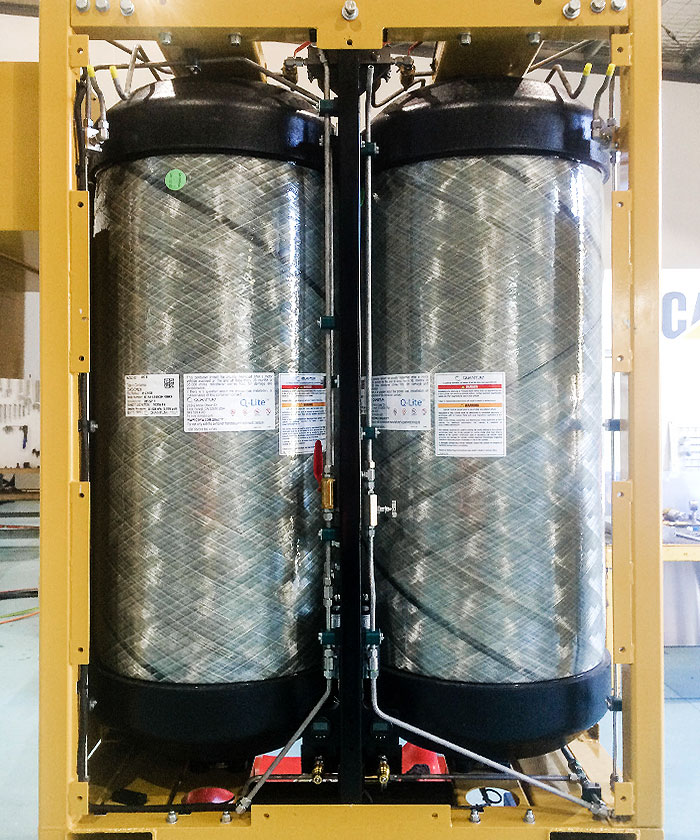Refuelling Options
Refuelling Station
The refuelling of mobile mining equipment with dual fuel conversion can be either by high-flow direct injection from a HDCNG® Dispenser (similar to a high-flow Diesel dispenser) directly into the HDCNG® Fuel Packs on the machine, or by an autonomous “swap and go” refuelling system of HDCNG® Cassettes.
Fuel Packs
The gas is chilled and directed into the HDCNG® Fuel Packs that are either designed for installation on mine trucks for fixed fast fill refuelling or as “swap and go” cassettes. In cases where HDCNG® is transported to the user location, specially designed gas transport crates may be used.
HDCNG® Fuel Packs designed for in situ fast fill refuelling contain four cylinders. There are two fuel packs, one mounted on either side of the truck. The drivers’ side pack is installed adjacent to a slimline diesel tank and the off side pack is adjacent to the corresponding hydraulic tank.
The autonomous “swap and go” HDCNG® Fuel Pack is a steel cradle containing two cassettes. Each cassette contains two cylinders. There are two cassettes on each side of the truck, contained in the steel cradles (i.e. a total of eight cylinders on the truck). The drivers’ side cradle is adjacent to the slimline diesel tank and the off side cradle is adjacent to the hydraulic tank.
“Swap and Go” Quick Exchange System
Where the “swap and go” system is used, cassettes are filled with gas and stored on a rack until required to refuel the machine. The cassette rack is located each side of the re-fuelling lane along with an autonomous cassette handling robot.
Robots are sourced from global manufacturers such as Kuka. These robots are similar to those commonly used in a wide variety of harsh, heavy duty industrial applications around the world. Each robot is located on a track specifically designed for the mine refuelling site.
Each cassette is allocated a unique identification (ID) number via the use of RFID (Radio Frequency Identification Device). An RFID reader is located on each side of the refilling bay to enable empty cassettes to be detected and allocated for refuelling. Laser technology, designed to operate in harsh mine site conditions, is used to guide the positioning of the robot in relation to the machine being refuelled. The cassettes are stored in either a one or two storey rack depending on truck fleet.
The autonomous “swap and go” refuelling station will be located in a position that is protected from the machine by earthen berms or such other means required by the local mine SSE (Senior Site Executive).
An additional smaller robot is installed on the driver’s side to refill the diesel tank autonomously.
The Cylinders
M.E.S. source Type IV Carbon Fibre Composite CNG cylinders from California based Quantum Fuel Systems.
M.E.S. cylinders have been purpose designed and sized specifically for each application. HDCNG® mine truck fuel packs are designed around available space on each make and model of mine truck. Larger cylinders are used for gas transport crates or gas storage modules.
Type IV Composite CNG Cylinders have evolved over several decades to become the pre-eminent choice for CNG fuel tanks on vehicles. This dominance has now extended to the hydrogen fuelled vehicle industry. High pressure rating, light weight, robustness and life cycle are all features that have supported this evolution.
Type IV Composite cylinders comprise three fundamental components:
- a cylindrical HDPE (plastic) liner with domed ends that contains the gas;
- metallic boss ends that fit onto the domed ends; and
- a carbon fibre filament wrap that is wound over the liner with a resin coating on the carbon fibres. The carbon fibre wind pattern is proprietary to the manufacturer but is always wound helically around the liner in a criss-cross pattern that results in an extremely tough mesh of carbon fibres glued in place by the resin. M.E.S. also include a thin fibreglass outer layer to protect the carbon fibre surface.
Certification Testing for Type IV Cylinders
The dominant codes regulating the fabrication of Type IV composite cylinders are NGV-2 2007 (US standard) and ISO 11439 (EU Standard). Both codes have similar requirements; Quantum Fuel Systems manufactures to NGV-2 2007.
There are a total of thirteen prescriptive tests detailed in NGV-2 for Type IV composite cylinders which includes a burst, fire, drop and ballistic test. All production cylinders must be designed to a minimum burst pressure of 2.25 times service pressure therefore a 10% margin is added to the 2.25 times to provide for deviations during cylinder production runs. The 350 barg service pressure cylinders used by M.E.S. are required to meet a minimum burst pressure of 12,500 psig during certification testing.
